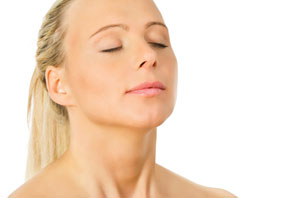|
|
|||
| Conscious Breathing
by Gay
Hendricks, PhD
|
|
||
|
FREE! Natural Weight Loss
Program recommended by The Share Guide
|
If you do not breathe well, it is almost impossible to feel good. Breathing, on the surface, seems like a simple thing to do, but scientific research shows clearly that most of us do not feel as good as we can, simply because we do not know how to breathe well. I have seen evidence indicating that as many as four out of five adults do not breathe well, and my clinical experience certainly confirms those studies. If there is one technique that I believe would be of most use to everyone, it is conscious breathing. There is considerable research documenting the effectiveness of breath work in dealing with many common psychological, health, and performance issues. Every student and client I have worked with over the last thirty years has benefited enormously from paying even a little bit of attention to their breathing. In fact, a little bit of attention is all it usually takes to learn how to breathe well. And breathing well is especially important, since you breathe as many as 20,000 times every day. What does a healthy, deep breath look and feel like? A healthy, deep in-breath occurs in three stages. It has a beginning, a middle, and a peak. It begins with a relaxation of your belly muscles. This relaxation allows the diaphragm to move downwards, which draws air into your lungs. So, in a healthy breath, your abdomen expands first before your chest moves, as air fills the lower portion of your lungs. The middle part of a healthy in-breath expands the chest muscles, which causes the rib cage to widen in three dimensions--towards the front, towards the sides, and towards the back. Your rib cage also moves upward as air fills the middle part of your lungs. At the very peak of the in-breath, your collarbones move upward, and your shoulders relax and move back slightly. This allows air to fill the upper part of your lungs. Now, let us look at the healthy out-breath. A healthy, deep out-breath goes through those same three stages in reverse. At its beginning, your collarbones drop and your shoulders move slightly forward. In the middle of your out-breath, your chest muscles relax and the rib cage moves downward and narrows in three dimensions. At the end of the healthy out-breath, your abdomen flattens and your belly muscles contract slightly. The most common mistake with breathing is to keep your belly muscles too tight, so that the diaphragm cannot flatten and move downward to allow a full in-breath. If this one problem can be solved, your breathing will dramatically increase in efficiency. Breathing Exercise: The Reset Button The Reset Button is a breathing practice that will bring the oxygen and carbon dioxide in your body into balance. This easy-to-learn technique can also be used in any situation when you need to instantly increase your state of relaxation, alertness, or mental clarity. The reason I call it the Reset Button is because one of my students pointed out that it works like the reset button on a computer--if your computer goes haywire, you have a button that will instantly reboot your system. The Reset Button is a technique that will instantly reset your biological system. Basic Instructions for The Reset Button Take a slow, easy breath all the way out, and then, when you come to the end of your out-breath, simply pause and rest until your body says, "Time to breathe." You will know when your oxygen balance point is reached when you experience a sense of harmony and well-being. And until you feel that sensation, just practice in a general, comfortable way. At first, you may only be able to go for a few seconds without needing to breathe back in. As you begin to practice this conscious breathing exercise, it is best if you first scan your body and mind to notice your current state of fatigue or mental fogginess, or any sense of anxiety or nervousness. Then, after you do a minute or so of this breathing technique, try to become aware of any changes in your body and mind. You can practice breathing in two minutes or less, anywhere, at any time--at your desk, in your car, even in a company meeting--whenever you need to instantly feel at your best or boost your performance. I urge you to take a few minutes every day to work on conscious breathing. Once you do, you will seldom have to think about it again. It will nurture you twenty thousand times a day with improved health and greater well-being. Excerpted with permission from The Breathing Box, a complete 4-week program with DVD, audio CD, guidebook and study cards--©2005 by Gay Hendricks, produced by Sounds True, Boulder Co. Available in stores or visit soundstrue.com. Shop Books & CD's by Gay Hendricks Related Info: Meditate in a Moment Meditation Doesn't Have to be Hard Being the Change We Seek Tai Chi: More Than Physical Exercise Mindful Yoga A 15 Minute Condensed Yoga Routine Rodney Yee on Yoga and Spirituality Kathlyn & Gay Hendricks on healing relationships Natural Weight Loss Program recommended by The Share Guide: learn more MORE
HEALTH ARTICLES  Follow us on Facebook Follow us on FacebookHome Shop |
||
|
|
|||
|
|
|
||

